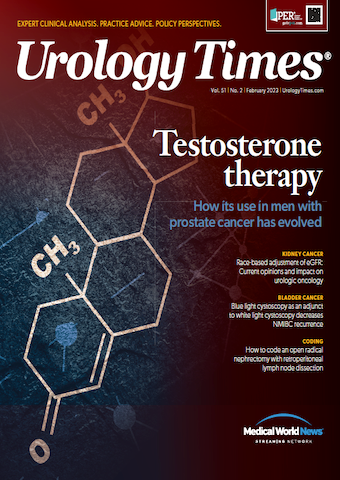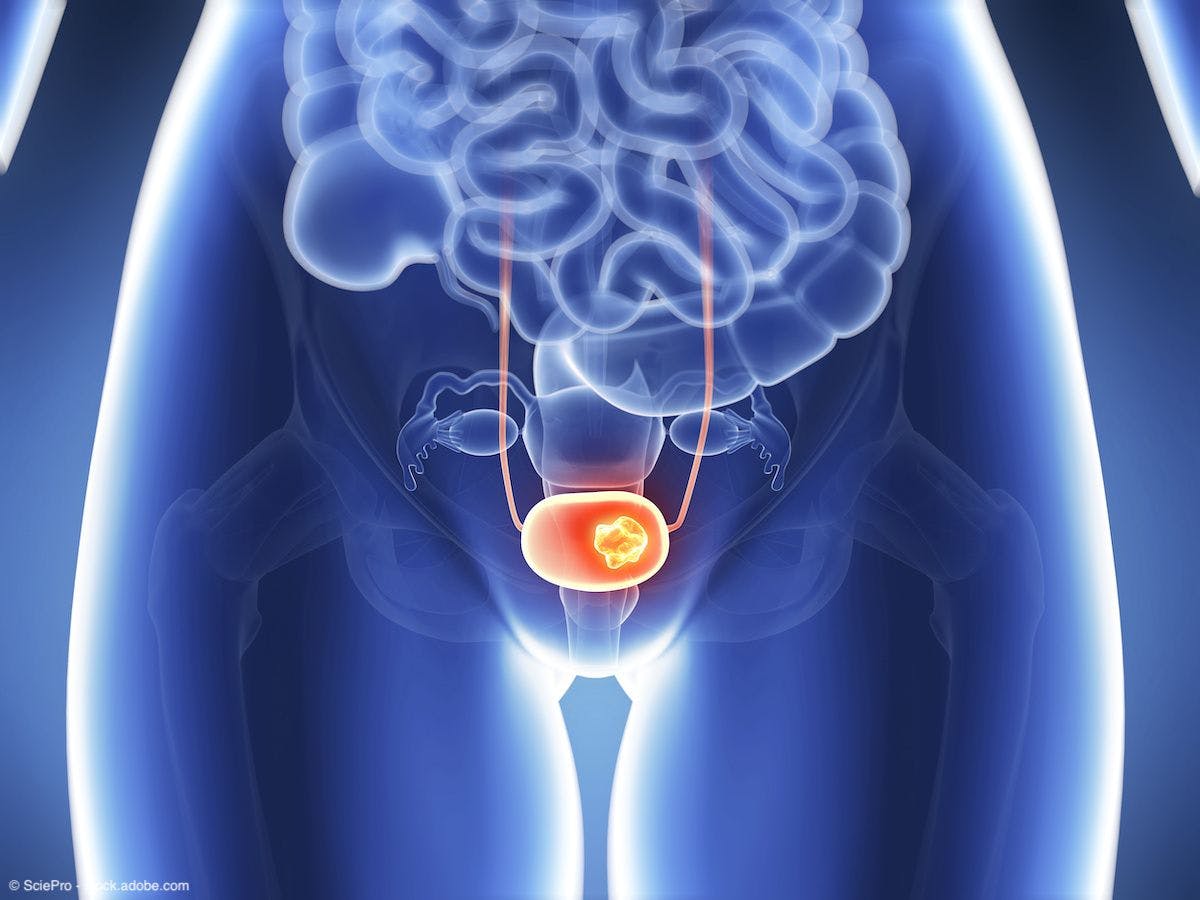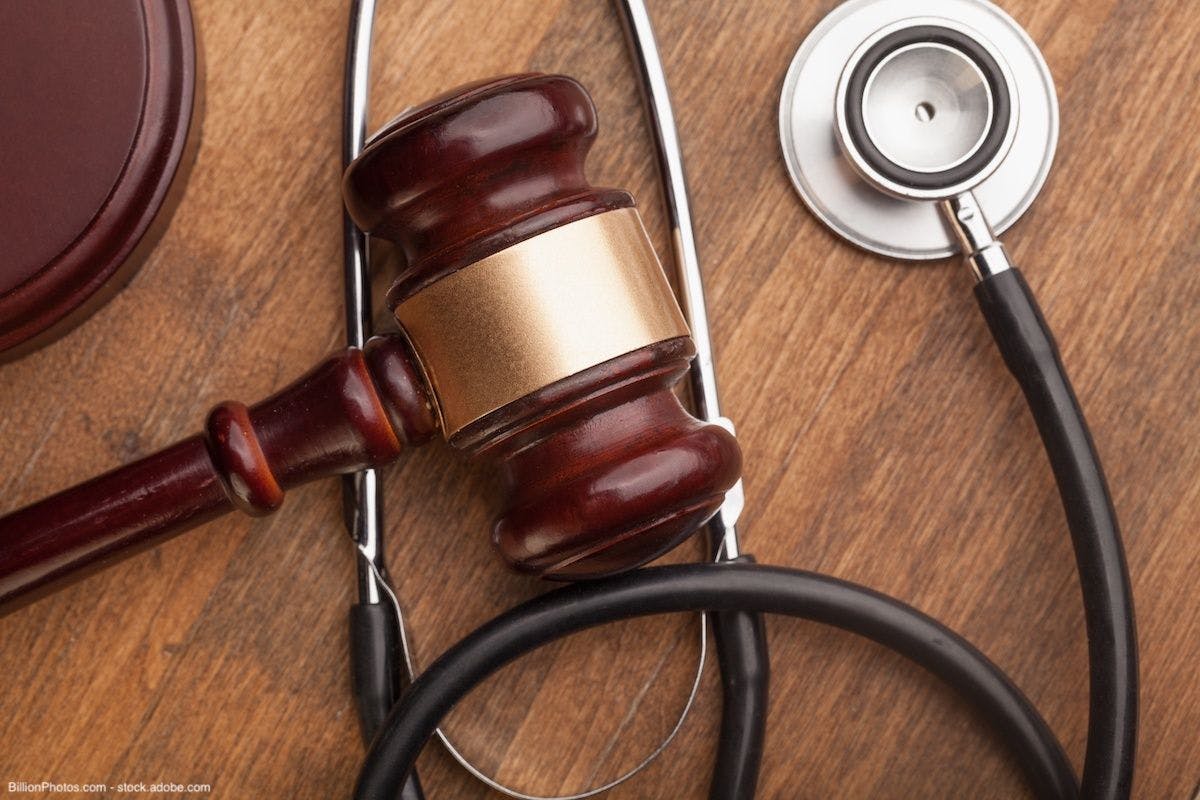Feature
Article
Urology Times Journal
Management of BCG-unresponsive NMIBC
Author(s):
"An alternative off-label option for patients with BCG-unresponsive NMIBC is sequential intravesical gemcitabine and docetaxel (Gem/Doce)," write Rachel Passarelli, MD, and Vignesh T. Packiam, MD.
Rachel Passarelli, MD

Bladder cancer is the 10th most common cancer worldwide with an estimated 82,000 new diagnoses and 17,000 deaths in 2023.1 The majority of patients present with non–muscle invasive bladder cancer (NMIBC).2 The current standard of care for high-risk (HR) NMIBC entails complete endoscopic resection with adjuvant induction and maintenance BCG therapy.3-5
Despite the ability of BCG to delay recurrence and reduce disease progression, around 40% of patients with HR disease ultimately will experience treatment failure.6-8 Although a variety of BCG failure scenarios exist, the term BCG-unresponsive is used to signify the point at which patients are highly unlikely to benefit from additional BCG, allowing for more homogeneous inclusion criteria for myriad new and ongoing clinical trials.
Vignesh T. Packiam, MD

Per FDA guidance, BCG-unresponsive disease is defined as being at least one of the following: (1) high-grade (HG) T1 disease at the first evaluation after induction BCG alone, (2) recurrent HG Ta/T1 disease within 6 months of completion of adequate BCG therapy, or (3) persistent or recurrent carcinoma in situ (CIS) alone with or without HG Ta/T1 disease within 12 months of completion of adequate BCG therapy.9,10 The definition of adequate BCG is receipt of at least 5 of 6 induction doses and at least 2 of 3 maintenance or 2 of 6 second induction doses.10
American Urological Association (AUA) guidelines suggest that radical cystectomy should be offered to patients with HR BCG-unresponsive NMIBC.3 However, many patients are poor candidates for radical surgery due to comorbidities or may strongly prefer bladder preservation treatment strategies. Furthermore, there is emerging evidence that an interval exists for appropriately selected patients to trial salvage therapies.11,12 There are 3 FDA-approved options for patients who are unwilling or unfit to undergo radical cystectomy with this diagnosis: intravesical valrubicin (Valstar), systemic pembrolizumab (Keytruda), and most recently nadofaragene firadenovec (Adstiladrin).13-15 A variety of other agents are used off-label or are under evaluation. Herein, we discuss available bladder-sparing treatment options for BCG-unresponsive NMIBC as well as avenues of exploration for future treatments.
Current FDA-approved options
Valrubicin
Intravesical valrubicin was approved as a treatment for BCG-unresponsive CIS in 1998. Preliminary results in a cohort of 90 patients suggested a complete response (CR) rate of 21% at 6 months, 8% at 1 year, and 3% at 2 years.16 Thus, this treatment is not commonly used in practice given its poor long-term results.
Pembrolizumab
Pembrolizumab, a PD-L1 inhibitor, was the second FDA-approved treatment option for BCG-unresponsive NMIBC, specifically CIS, as of 2020. In the phase 2 KEYNOTE-057 trial (NCT02625961), 101 patients with BCG-unresponsive CIS with or without papillary lesions were given intravenous pembrolizumab 200 mg every 3 weeks for up to 24 months or until disease progression.17 In this cohort of patients, 40% had CR after 3 months, and 19% had CR by the 1-year mark. Aside from modest efficacy, a major limitation of pembrolizumab is its adverse systemic immune effects: Overall, 13% of patients on trial experienced a grade 3 or higher adverse event, which led to discontinuation of treatment in 7% of the cohort.17 Pembrolizumab is also expensive, and, when compared with radical cystectomy or salvage intravesical chemotherapy, is not considered a cost-effective treatment in any simulated settings.18
Nadofaragene firadenovec
Nadofaragene firadenovec was most recently approved by the FDA for BCG-unresponsive NMIBC in late 2022. In a prospective phase 3 study (NCT02773849) by Boorjian et al, 157 patients with BCG-unresponsive NMIBC were treated with a single dose of intravesical nadofaragene firadenovec, which is a modified adenovirus that delivers IFN-α2b complementary DNA to the bladder epithelium. Maintenance dosing was given at 3, 6, and 9 months in patients who remained recurrence free. The overall cohort experienced an initial CR of 60% and a 1-year CR of 30%. Only 5% of trial patients progressed to muscle invasive disease. Grade 3 or higher adverse events were reported in 4% of the patients.19 Although the final price of nadofaragene firadenovec remains to be determined, preliminary analysis suggests its cost may render this option preclusive, similar to pembrolizumab.20
Gemcitabine/docetaxel
An alternative off-label option for patients with BCG-unresponsive NMIBC is sequential intravesical gemcitabine and docetaxel (Gem/Doce). Based on the original 2015 Gem/Doce study, this treatment regimen consists of 6 weekly instillations of 1 g of gemcitabine followed by 37.5 mg of docetaxel.21 In a retrospective multi-institutional study of 276 patients with recurrent NMIBC and prior BCG treatment who received Gem/Doce, high-grade recurrence-free survival (RFS) was 65% and 52% at 1 and 2 years, respectively.22 Only 4% of patients had disease progression.22 A similar longer-term follow-up analysis of 97 patients suggested that at 1, 2, and 5 years, high-grade RFS was 60%, 50%, and 30%, respectively, without any grade 3 or higher adverse events. In the BCG-unresponsive cohort, at 5 years, RFS was 28%, progression-free survival was 89%, cystectomy-free survival was 74%, and overall survival was 66%, suggesting that the majority of recurrences can be managed safely without progression or need for cystectomy.23 Despite the lack of prospective trials on the combination of gemcitabine/docetaxel, this practice is heavily utilized today as it is safe, accessible, and cost-effective in a realm of limited real-world options.24,25
Clinical Trials
Given the paucity of approved effective nonsurgical options for patients with BCG-unresponsive NMIBC, AUA guidelines also advise that clinical trials may be considered for this patient population.3 Following is information about some ongoing clinical trials that show promise for future advancements.
CG0070
CG0070, an oncolytic adenovirus that targets bladder tumor cells through defects in the retinoblastoma pathway, has been shown to be a safe, effective treatment for patients with BCG-unresponsive NMIBC. In a phase 2 study (NCT02365818) of 45 patients with BCG-unresponsive NMIBC who received CG0070 monotherapy, the overall 6-month CR was 47%, with particularly strong response in the cohort with pure CIS (58%).26 Preliminary results of a phase 2 study (NCT04387461) involving a combination of intravesical CG0070 and intravenous pembrolizumab in a cohort of 24 patients have shown promise: 92% CR rate at 3 months and 75% at 1 year for the 8-patient subcohort with sufficient follow-up.27
TAR-200
Another area of growing research involves novel drug delivery systems. TAR-200 is an intravesical drug delivery system that provides release of gemcitabine via an indwelling device over a 2-week course.28 TAR-200 is being studied in combination with cetrelimab (PD-1 inhibitor) in the BCG-unresponsive NMIBC population. Initial results suggest an anytime CR of 88% in patients receiving TAR-200 alone with only 8% (1/13) of patients experiencing a grade 3 or higher adverse event. Results from patients receiving cetrelimab alone are comparable to other PD-1 inhibitor monotherapy treatments (anytime CR rate of 38%).29 Future trials should continue to explore alternative TAR device therapies, including the pan–fibroblast growth factor receptor tyrosine kinase inhibitor erdafitinib (Balversa).
NAI
Nogapendekin alfa inbakicept (NAI), an IL-15 superagonist previously known as N-803, is postulated to act synergistically with BCG.30,31 In a recent trial, 82 patients with BCG-unresponsive CIS with or without papillary disease achieved a CR of 55%, 46%, and 45% at 3, 6, and 12 months, respectively, when treated with combination intravesical BCG and NAI.32 Of patients who experienced CR, 90% avoided cystectomy at 24 months, and 20% of patients had a grade 3 or higher adverse event, of which 3 were immune-related. In those who received NAI alone, CR at 3 months was achieved in only 20% (2/10) of patients.32 NAI is under investigation for approval by the FDA as an option for patients with BCG-unresponsive NMIBC.
Future directions
A variety of other novel treatments are under evaluation for BCG-unresponsive NMIBC, and there is a boom of research efforts directed at this disease. Unfortunately, bladder-sparing options remain limited for patients with BCG-unresponsive NMIBC. Although real-world options have evolved, only pembrolizumab and nadofaragene firadenovec have received FDA approval in recent years. Despite this, these options are not widely utilized due to accessibility and cost. Further clinical trial participation is needed as there are several promising therapies on the horizon with potential to broaden the landscape of treatment options for BCG-unresponsive NMIBC.
References
1. Siegel RL, Miller KD, Wagle NS, Jemal A. Cancer statistics, 2023. CA Cancer J Clin. 2023;73(1):17-48. doi:10.3322/caac.21763
2. van Rhijn BWG, Burger M, Lotan Y, et al. Recurrence and progression of disease in non–muscle-invasive bladder cancer: from epidemiology to treatment strategy. Eur Urol. 2009;56(3):430-442. doi:10.1016/j.eururo.2009.06.028
3. Chang SS, Boorjian SA, Chou R, et al. Diagnosis and treatment of non-muscle invasive bladder cancer: AUA/SUO guideline. J Urol. 2016;196(4):1021-1029. doi:10.1016/j.juro.2016.06.049
4. Flaig TW, Spiess PE, Agarwal N, et al. Bladder cancer, version 3.2020, NCCN Clinical Practice Guidelines in Oncology. J Natl Compr Canc Netw. 2020;18(3):329-354. doi:10.6004/jnccn.2020.0011
5. Babjuk M, Burger M, Compérat EM, et al. European Association of Urology guidelines on non-muscle-invasive bladder cancer (TaT1 and carcinoma in situ) - 2019 update. Eur Urol. 2019;76(5):639-657. doi:10.1016/j.eururo.2019.08.016
6. Sylvester RJ, van der MEIJDEN APM, Lamm DL. Intravesical bacillus Calmette-Guerin reduces the risk of progression in patients with superficial bladder cancer: a meta-analysis of the published results of randomized clinical trials. J Urol. 2002;168(5):1964-1970. doi:10.1016/S0022-5347(05)64273-5
7. Hussain MHA, Wood DP, Bajorin DF, et al. Bladder cancer: narrowing the gap between evidence and practice. J Clin Oncol. 2009;27(34):5680-5684. doi:10.1200/JCO.2009.23.6901
8. Zlotta AR, Fleshner NE, Jewett MA. The management of BCG failure in non-muscle-invasive bladder cancer: an update. Can Urol Assoc J. 2009;3(6 suppl 4):S199-S205. doi:10.5489/cuaj.1196
9. Kamat AM, Sylvester RJ, Böhle A, et al. Definitions, end points, and clinical trial designs for non–muscle-invasive bladder cancer: recommendations from the International Bladder Cancer Group. J Clin Oncol. 2016;34(16):1935-1944. doi:10.1200/JCO.2015.64.4070
10. US Department of Health and Human Services; FDA; Center for Drug Evaluation and Research; Center for Biologics Evaluation and Research. BCG-unresponsive nonmuscle invasive bladder cancer: developing drugs and biologics for treatment guidance for industry. February 2018. Accessed December 1, 2023. https://www.fda.gov/media/101468/download
11. Packiam VT, Richards J, Schmautz M, Heidenreich A, Boorjian SA. The current landscape of salvage therapies for patients with bacillus Calmette-Guérin unresponsive nonmuscle invasive bladder cancer. Curr Opin Urol. 2021;31(3):178-187. doi:10.1097/MOU.0000000000000863
12. Tan WS, Grajales V, Contieri R, et al. Bladder-sparing treatment in patients with bacillus Calmette-Guerin–unresponsive non–muscle-invasive bladder cancer: an analysis of long-term survival outcomes. Eur Urol Open Sci. 2023;53:16-22. doi:10.1016/j.euros.2023.04.013
13. Wright KM. FDA approves pembrolizumab for BCG-unresponsive NMIBC. Oncology (Williston Park). 2020;34(2):44.
14. Grossman HB, O'Donnell MA, Cookson MS, Greenberg RE, Keane TE. Bacillus calmette-guérin failures and beyond: contemporary management of non-muscle-invasive bladder cancer. Rev Urol. 2008;10(4):281-289.
15. Lee A. Nadofaragene firadenovec: first approval. Drugs. 2023;83(4):353-357. doi:10.1007/s40265-023-01846-z
16. Steinberg G, Bahnson R, Brosman S, Middleton R, Wajsman Z, Wehle M. Efficacy and safety of valrubicin for the treatment of Bacillus Calmette-Guerin refractory carcinoma in situ of the bladder. The Valrubicin Study Group. J Urol. 2000;163(3):761-767.
17. Balar AV, Kamat AM, Kulkarni GS, et al. Pembrolizumab monotherapy for the treatment of high-risk non-muscle-invasive bladder cancer unresponsive to BCG (KEYNOTE-057): an open-label, single-arm, multicentre, phase 2 study. Lancet Oncol. 2021;22(7):919-930. doi:10.1016/S1470-2045(21)00147-9
18. Wymer KM, Sharma V, Saigal CS, et al. Cost-effectiveness analysis of pembrolizumab for bacillus Calmette-Guérin–unresponsive carcinoma in situ of the bladder. J Urol. 2021;205(5):1326-1335. doi:10.1097/JU.0000000000001515
19. Boorjian SA, Alemozaffar M, Konety BR, et al. Intravesical nadofaragene firadenovec gene therapy for BCG-unresponsive non-muscle-invasive bladder cancer: a single-arm, open-label, repeat-dose clinical trial. Lancet Oncol. 2021;22(1):107-117. doi:10.1016/S1470-2045(20)30540-4
20. Joshi M, Atlas SJ, Beinfeld M, et al. Cost-effectiveness of nadofaragene firadenovec and pembrolizumab in bacillus Calmette-Guérin immunotherapy unresponsive non–muscle invasive bladder cancer. Value Health. 2023;26(6):823-832. doi:10.1016/j.jval.2022.12.005
21. Steinberg RL, Thomas LJ, O'Donnell MA, Nepple KG. Sequential intravesical gemcitabine and docetaxel for the salvage treatment of non-muscle invasive bladder cancer. Bladder Cancer. 2015;1(1):65-72. doi:10.3233/BLC-150008
22. Steinberg RL, Thomas LJ, Brooks N, et al. Multi-institution evaluation of sequential gemcitabine and docetaxel as rescue therapy for nonmuscle invasive bladder cancer. J Urol. 2020;203(5):902-909. doi:10.1097/JU.0000000000000688
23. Chevuru PT, McElree IM, Mott SL, Steinberg RL, O'Donnell MA, Packiam VT. Long-term follow-up of sequential intravesical gemcitabine and docetaxel salvage therapy for non–muscle invasive bladder cancer. Urol Oncol. 2023;41(3):148.e1-148.e7. doi:10.1016/j.urolonc.2022.10.030
24. Roumiguié M, Black PC. Sequential gemcitabine plus docetaxel is the standard second-line intravesical therapy for BCG-unresponsive non–muscle-invasive bladder cancer: Pro. Eur Urol Focus. 2022;8(4):1117-1120. doi:10.1016/j.euf.2021.07.018
25. Packiam VT, Gabrielson AT, Kates M. Intravesical gemcitabine and docetaxel for nonmuscle-invasive bladder cancer. AUA News.June 1, 2022. Accessed December 1, 2023. https://auanews.net/issues/articles/2022/june-2022/intravesical-gemcitabine-and-docetaxel-for-nonmuscle-invasive-bladder-cancer
26. Packiam VT, Lamm DL, Barocas DA, et al. An open label, single-arm, phase II multicenter study of the safety and efficacy of CG0070 oncolytic vector regimen in patients with BCG-unresponsive non–muscle-invasive bladder cancer: interim results. Urol Oncol. 2018;36(10):440-447. doi:10.1016/j.urolonc.2017.07.005
27. Li R, Steinberg G, Lamm D, et al. CORE1: phase 2 single arm study of CG0070 combined with pembrolizumab in patients with non muscle invasive bladder cancer (NMIBC) unresponsive to bacillus Calmette-Guerin (BCG). J Urol. 2022;207(suppl 5S):e927.
28. Grimberg DC, Shah A, Inman BA. Overview of Taris GemRIS, a novel drug delivery system for bladder cancer. Eur Urol Focus. 2020;6(4):620-622. doi:10.1016/j.euf.2019.09.006
29.Daneshmand S, van der Heijden MS, Jacob JM, et al. LBA02-03: First results from SunRISE-1 in patients with BCG unresponsive high-risk non–muscle-invasive bladder cancer receiving TAR-200 in combination with cetrelimab, TAR-200, or cetrelimab alone. J Urol. 2023;209(suppl 4):e1187. doi:10.1097/JU.0000000000003361
30.Seymour C. FDA accepts BLA for N-803 in BCG-unresponsive non–muscle invasive bladder cancer in situ. Oncology Live Urologists in Cancer Care®. Published online August 1, 2022. Accessed December 1, 2023. https://www.onclive.com/view/fda-accepts-bla-for-n-803-in-bcg-unresponsive-non-muscle-invasive-bladder-cancer-in-situ
31.Ryan C. FDA issues complete response letter to BLA for N-803 in BCG-unresponsive NMIBC in situ. Oncology Live Urologists in Cancer Care®. Published online May 11, 2023. Accessed December 1, 2023. https://www.onclive.com/view/fda-issues-complete-response-letter-to-bla-for-n-803-in-bcg-unresponsive-nimbc-in-situ
32. Chamie K, Chang SS, Kramolowsky E, et al. IL-15 superagonist NAI in BCG-unresponsive non–muscle-invasive bladder cancer. NEJM Evid. 2023;2(1). doi:10.1056/EVIDoa2200167

Newsletter
Stay current with the latest urology news and practice-changing insights — sign up now for the essential updates every urologist needs.






















